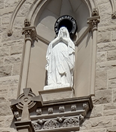Typology: Difference between revisions
Appearance
No edit summary |
No edit summary |
||
| Line 1: | Line 1: | ||
'''Typology''' is the study of "types" or pre-figurements of Christ and other Scriptural persons or things | '''Typology''' is the study of "types" or pre-figurements of Christ and other Scriptural persons or things and events that point to the fulfillment of the Old Covenant by Jesus Christ. | ||
“Do not think that I have come to abolish the law or the prophets. I have come not to abolish but to fulfill.” | See also [[Salvation History]] | ||
<nowiki>**</nowiki> page under construction ** | |||
“Do not think that I have come to abolish the law or the prophets. I have come not to abolish but to fulfill.” ([https://bible.usccb.org/bible/matthew/5?17 Mt 5:17-19]) | |||
== Typology as a tool for understanding the History of Salvation == | == Typology as a tool for understanding the History of Salvation == | ||
| Line 9: | Line 11: | ||
** by which Christ redeems mankind from the Fall of Adam and Eve. | ** by which Christ redeems mankind from the Fall of Adam and Eve. | ||
== | * | ||
== Mary and the Ark == | |||
Mary the Mother of God parallels to many Old Testament types, but one of the most important is to the Ark of the Covenant. | |||
WIth the Incarnation, we begin the New Covenant, or fulfillment of the Old Covenant. | |||
{| class="wikitable" | |||
|+ | |||
! | |||
!Old Testament | |||
!Mary | |||
|- | |||
|The Ark of the Covenant | |||
|The Ark moved to >> house for 3 months | |||
|Mary visits Elizabeth | |||
|- | |||
| | |||
|David dances | |||
|John leaps for Joy from the womb | |||
|- | |||
|John the Baptist | |||
|Elizabeth and Zachariah are a type for the Old Covenant | |||
(faithful to it) | |||
|John marks the New Covenant and serves to announce it literally in his mission | |||
|- | |||
| | |||
| | |||
| | |||
|} | |||
== | == Biblical parallels (misc) == | ||
=== Two sons === | === Two sons === | ||
| Line 26: | Line 54: | ||
** Jacob and Esau | ** Jacob and Esau | ||
** Adonijah and Solomon | ** Adonijah and Solomon | ||
== Sources == | |||
* [https://towerofadam.substack.com/p/typology-part-1-an-introduction Typology: Part 1 An Introduction - by Brother Alexander (substack.com)] | |||
* 9. [https://bible.org/seriespage/9-typology-christ Typology of Christ | Bible.org] | |||
[[Category:Bible]] | [[Category:Bible]] | ||
[[Category:Catechism of the Catholic Church]] | [[Category:Catechism of the Catholic Church]] | ||
Revision as of 09:43, 1 June 2024
Typology is the study of "types" or pre-figurements of Christ and other Scriptural persons or things and events that point to the fulfillment of the Old Covenant by Jesus Christ.
See also Salvation History
** page under construction **
“Do not think that I have come to abolish the law or the prophets. I have come not to abolish but to fulfill.” (Mt 5:17-19)
Typology as a tool for understanding the History of Salvation
- typology reveals the parallels between the Old and New Testaments
- which helps us to understand "Salvation History," or "God's Plan for Salvation
- by which Christ redeems mankind from the Fall of Adam and Eve.
Mary and the Ark
Mary the Mother of God parallels to many Old Testament types, but one of the most important is to the Ark of the Covenant.
WIth the Incarnation, we begin the New Covenant, or fulfillment of the Old Covenant.
| Old Testament | Mary | |
|---|---|---|
| The Ark of the Covenant | The Ark moved to >> house for 3 months | Mary visits Elizabeth |
| David dances | John leaps for Joy from the womb | |
| John the Baptist | Elizabeth and Zachariah are a type for the Old Covenant
(faithful to it) |
John marks the New Covenant and serves to announce it literally in his mission |
Biblical parallels (misc)
Two sons
- the Parable of the Prodigal Son starts
A man had two sons... (Lk 15:11)
- unrelated to the parable, but "two sons" or sibling rivalries ocurr across the Bible:
- Cain and Abel
- Ishmael and Isaac
- Jacob and Esau
- Adonijah and Solomon
